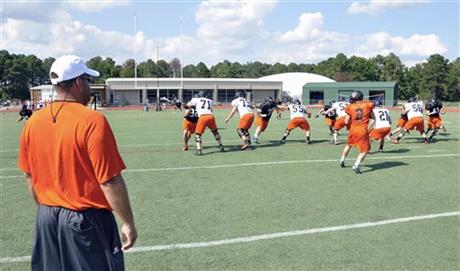By Mike Kuchar
Senior Research Manager
X&O Labs
Twitter: @MikekKuchar
Introduction
 When directing a tempo offense, communication is everything and a simple miscommunication can result in travesty within seconds. There are two key cogs in running the tempo offense- the offensive coordinator and the quarterback and how these two individuals work together is in direct relation to how proficient the offense becomes. On a play-by-play pre-snap basis, the quarterback is asked to survey information, digest information and communicate information in a matter of seconds. All of this information is provided by offensive coordinators during the course of the game week. We wanted to research specifically how these communication is conveyed between the coordinator and the quarterback so we surveyed nine offensive coordinators at both the high school and college level to ask them the following questions:
When directing a tempo offense, communication is everything and a simple miscommunication can result in travesty within seconds. There are two key cogs in running the tempo offense- the offensive coordinator and the quarterback and how these two individuals work together is in direct relation to how proficient the offense becomes. On a play-by-play pre-snap basis, the quarterback is asked to survey information, digest information and communicate information in a matter of seconds. All of this information is provided by offensive coordinators during the course of the game week. We wanted to research specifically how these communication is conveyed between the coordinator and the quarterback so we surveyed nine offensive coordinators at both the high school and college level to ask them the following questions:
- How they teach their quarterback to identify defensive fronts and how many types of fronts he is expected to identify.
- How they teach their quarterback to identify coverage and how these coverages are labeled in their system.
- What landmarks these coaches use to define the “box count” and how a box is labeled.
- How leverage is defined on the perimeter, particularly as it pertains to covered and uncovered receivers.
- What these coaches are doing in the film room and the meeting room to teach their quarterbacks these concepts.
Their responses are left anonymous because, well…like we said communication is everything in their system. It’s the tight lipped, CIA style of these no-huddle signal callers to not tip their hand. But they did disclose the method by which they design their communication and we segmented their responses based on whether they are high school (prep) or college coaches. The participants to the study are below:
Participants (in alphabetical order):
Dave Brown, Fort Lewis College (CO)
David Buchanan, Quabbin Regional High School (MA)
Dan Ellis, Great Valley High School (PA)
Bryon Hamilton, Shasta College (CA)
Jordan Neal, Henrix University (AR)
Chris Parker, Pikens County Schools (GA)
Mike Schmitz, Ohio Northern University
Joe Spagnolo, Iona Prep High School (NY)
Henry Stanford, Hiram College (OH)
Steve Steele, Pierre TF Riggs High School (SD)
Explain how you teach your quarterback to identify defensive fronts. How many types of fronts is he expected to identify? How do you name or tag these fronts?
NCAA Coaches Responses:
“When it comes to identifying defensive fronts, the only thing I concern my quarterback with is counting the front and deciphering between—in most cases—an even front with four defensive linemen or an odd front with three defensive linemen. Although we do, on occasion, witness bear fronts (50 or double eagle front) and a 6-man (6-1) front, those are extremely rare for us. There are typically enough other factors on the back-end, such as press man coverage and the presence of a single deep safety that tip these rarities off and allow us to adjust accordingly. Otherwise, we can expect a basic even or odd front. Once our quarterback determines 4 or 3 down linemen, he is conditioned to simply reduce his math down to two remaining variables: How many second-level defenders are there? Once that is determined, he can, more or less, make an assumption about the coverage. For instance, if there are four down linemen, then the only remaining question is, where are the other seven defenders located and how are they configured? The second question is, how many safeties are there? The quarterback should be able to gather a significant amount of intelligence prior to the snap of the football based on the simple determination of how many defensive linemen there are. Because there are too many variables involved with various run blocking schemes, we do not expect our quarterback to concern himself with specific DL techniques. We don’t run the inside zone only to a 2i, and we don’t only run power to a 3 tech. Because we encounter such different DL nuances from week-to-week, we don’t spend a great deal of time coaching the QB to check those plays either way. We teach our offensive line to block vs. best-case scenarios and worst-case scenarios. This allows us to play fast and limit the amount of information our QB has to process on a given play.”








